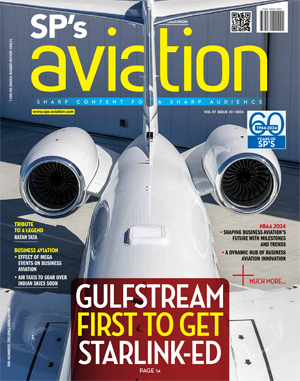INDIAN ARMED FORCES CHIEFS ON OUR RELENTLESS AND FOCUSED PUBLISHING EFFORTS

SP Guide Publications puts forth a well compiled articulation of issues, pursuits and accomplishments of the Indian Army, over the years

"Over the past 60 years, the growth of SP Guide Publications has mirrored the rising stature of Indian Navy. Its well-researched and informative magazines on Defence and Aerospace sector have served to shape an educated opinion of our military personnel, policy makers and the public alike. I wish SP's Publication team continued success, fair winds and following seas in all future endeavour!"

Since, its inception in 1964, SP Guide Publications has consistently demonstrated commitment to high-quality journalism in the aerospace and defence sectors, earning a well-deserved reputation as Asia's largest media house in this domain. I wish SP Guide Publications continued success in its pursuit of excellence.
Missed Opportunity

Collaboration between China and Sri Lanka in space technology should be viewed in the context of national security and ought to be a matter of serious concern for India
On Nov ember 27, 2012, the Chinese Government-run Great Wall Industry Corporation (GWIC) in partnership with SupremeSat, a private company in Sri Lanka, is reported to have launched the nation’s first satellite from the Xichang Satellite Launch Centre in Sichuan province of China. In fact the space vehicle launched is a Thales-built commercial geostationary communication satellite, originally called Apstar-7B with 24 C band and 23 Ku band high power beams. It was renamed as ChinaSat-12 or Zhongxing-12 and part of the satellite’s communications payload has been leased to Sri Lanka and the satellite cobranded as SupremeSat I. The SupremeSat I is meant to bring remote areas of the island under television coverage.
The Sri Lankan company has entered into an agreement with GWIC for launching additional satellites in the series as also to establish with Chinese assistance, a $320 million ( Rs. 1,600 crore) project, involving the construction of a Space Academy in Sri Lanka. Officially, the Government of Sri Lanka was not involved with the launch of SupremeSat I beyond according in-principle approval and moral support. However, Rohitha Rajapaksa, the youngest son of the Sri Lankan President, is believed to have business links with Supreme-Sat and has played a key role in the project.
China’s satellite programme has, in recent years, been expanding its reach to countries including Pakistan, Nigeria, Bolivia and Venezuela. This is driven largely by commercial considerations other than in respect of Pakistan. But China’s assistance to Sri Lanka in the regime of space technology should not be seen only as a commercial venture but as a manifestation of the growing strategic and economic ties between the two nations. Although relations between China and Sri Lanka predates the colonial era, the seeds of friendship in the recent times between the two were sowed when in 1950, the former recognised the People’s Republic of China. Thereafter, the two nations entered into trade agreements leading to grant of most-favoured nation status mutually in the 1980s. China supported the Sri Lankan Government in the three-decade civil war against Tamil insurgency beginning in the mid-1970s, during the period when India was sympathetic to the Tamil secessionist groups. China supplied weapons, ammunition and other military equipment to the Sri Lankan Government to defeat the Tamil Tigers.
Since the end of the ethnic conflict on the island in May 2009, China has been helping Sri Lanka economically and playing a major role in its post-war reconstruction programme. Today, China has become the largest donor, lender and investor in Sri Lanka and has undertaken several major infrastructure projects including construction of sea ports, airports, expressways, thermal power plants, railways and irrigation infrastructure, altogether valued at over $6 billion ( Rs. 30,000 crore). As reported, currently, there are about 16,000 engineers and other personnel from China deployed in Sri Lanka in the different projects. As a result of Sri Lanka’s dependence on China during the civil war, the relationship between the two nations has rapidly expanded beyond the economic assistance into the domain of strategic and defence cooperation including modernisation of military training. In all likelihood, the relationship is set to strengthen and expand further in the years ahead. Although China has stated that the ties with Sri Lanka are aimed at maintaining regional stability and are not targeted at any other nation, the developments should logically be of concern not only for India but also for its new strategic partner, the US. The Obama Administration is crafting new paradigms for engagement by the US in Asia, an exercise that has the potential for a conflict with China.





